Alcopops Tax and Black Market
VerifiedAdded on 2020/05/28
|13
|1900
|412
AI Summary
This assignment examines the consequences of imposing a tax on Alcopops. It analyzes how an inelastic demand for Alcopops leads to consumers bearing the tax burden despite potential addiction among teenagers. The analysis also highlights the emergence of a black market due to the tax, reducing government revenue. Finally, it suggests policy solutions at both central and state levels to curb Alcopops consumption and related hospitalizations.
Contribute Materials
Your contribution can guide someone’s learning journey. Share your
documents today.
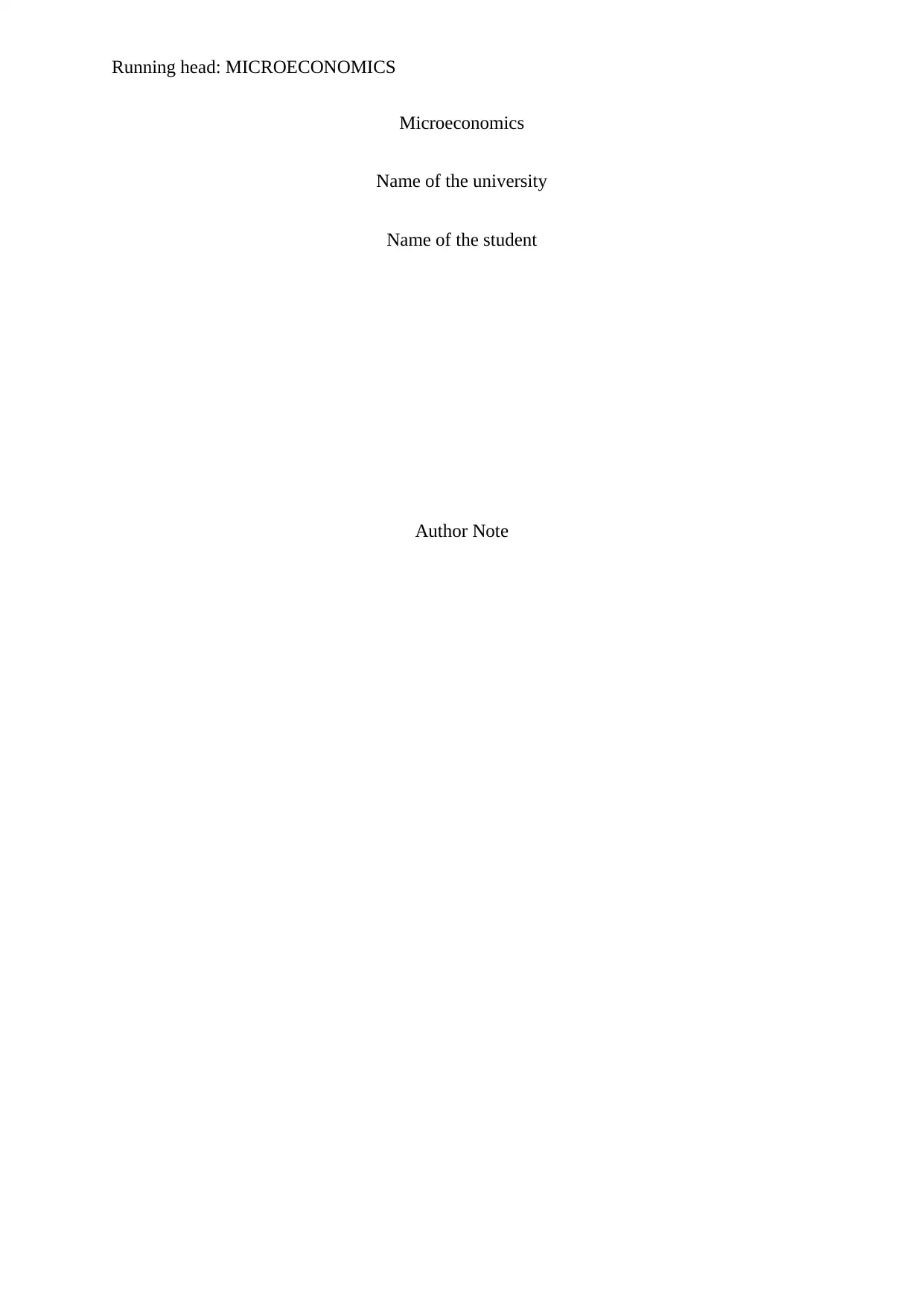
Running head: MICROECONOMICS
Microeconomics
Name of the university
Name of the student
Author Note
Microeconomics
Name of the university
Name of the student
Author Note
Secure Best Marks with AI Grader
Need help grading? Try our AI Grader for instant feedback on your assignments.
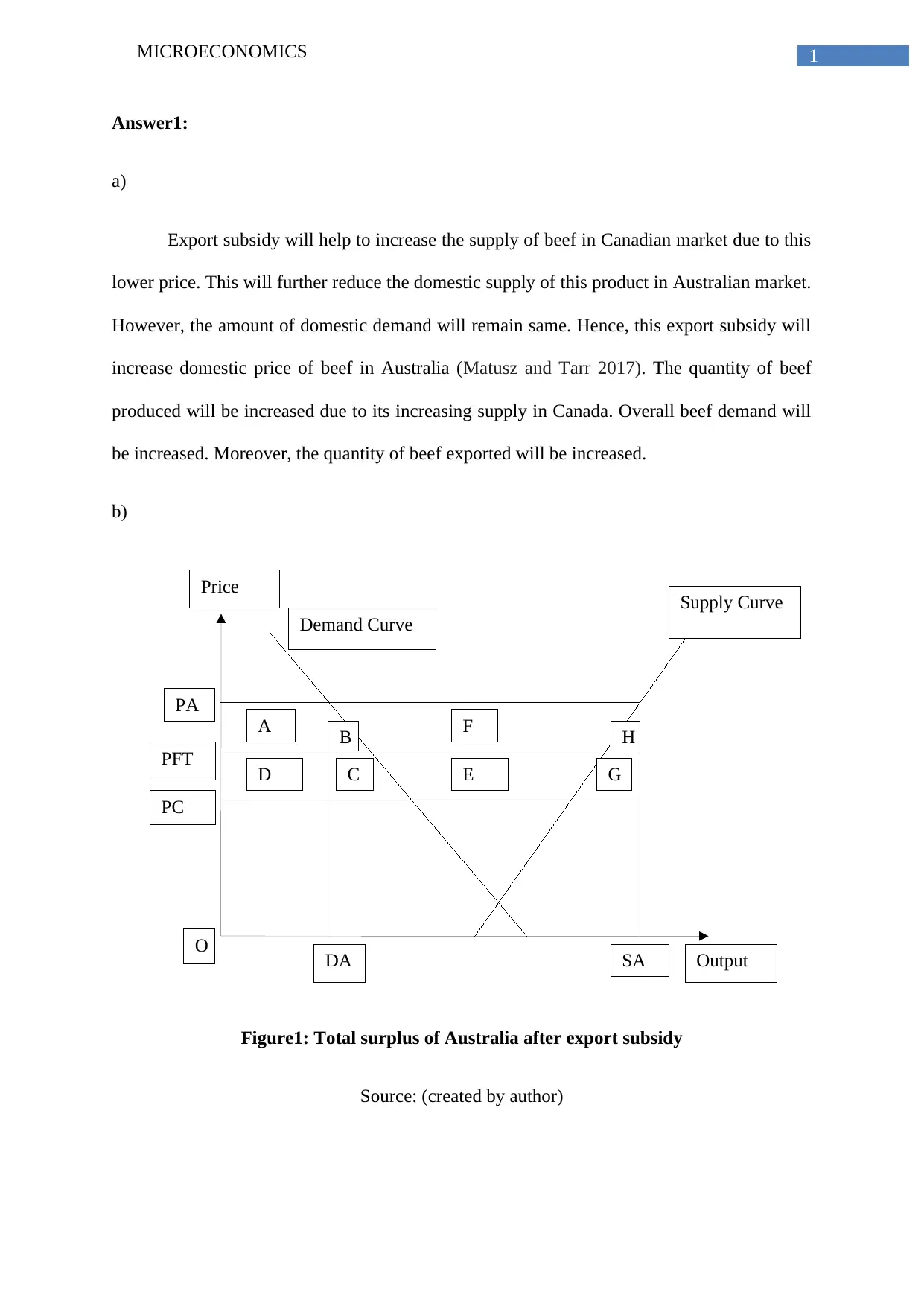
1MICROECONOMICS
Demand Curve
Supply Curve
Price
Output
O
A
D C
B
E
F
G
H
PA
PC
PFT
DA SA
Answer1:
a)
Export subsidy will help to increase the supply of beef in Canadian market due to this
lower price. This will further reduce the domestic supply of this product in Australian market.
However, the amount of domestic demand will remain same. Hence, this export subsidy will
increase domestic price of beef in Australia (Matusz and Tarr 2017). The quantity of beef
produced will be increased due to its increasing supply in Canada. Overall beef demand will
be increased. Moreover, the quantity of beef exported will be increased.
b)
Figure1: Total surplus of Australia after export subsidy
Source: (created by author)
Demand Curve
Supply Curve
Price
Output
O
A
D C
B
E
F
G
H
PA
PC
PFT
DA SA
Answer1:
a)
Export subsidy will help to increase the supply of beef in Canadian market due to this
lower price. This will further reduce the domestic supply of this product in Australian market.
However, the amount of domestic demand will remain same. Hence, this export subsidy will
increase domestic price of beef in Australia (Matusz and Tarr 2017). The quantity of beef
produced will be increased due to its increasing supply in Canada. Overall beef demand will
be increased. Moreover, the quantity of beef exported will be increased.
b)
Figure1: Total surplus of Australia after export subsidy
Source: (created by author)
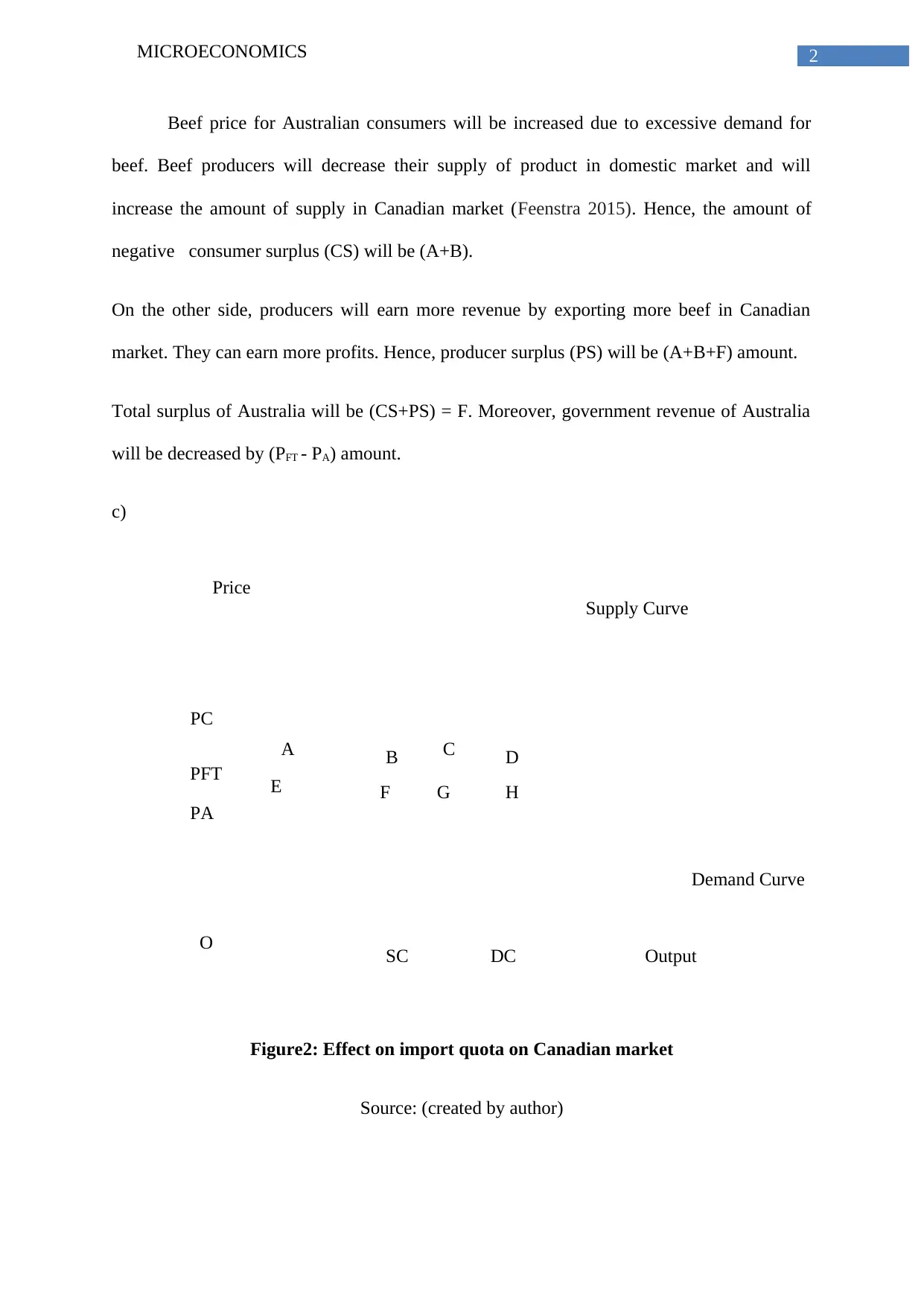
2MICROECONOMICS
Supply Curve
Demand Curve
PFT
PC
PA
O
A
E F G H
DCB
SC DC
Price
Output
Beef price for Australian consumers will be increased due to excessive demand for
beef. Beef producers will decrease their supply of product in domestic market and will
increase the amount of supply in Canadian market (Feenstra 2015). Hence, the amount of
negative consumer surplus (CS) will be (A+B).
On the other side, producers will earn more revenue by exporting more beef in Canadian
market. They can earn more profits. Hence, producer surplus (PS) will be (A+B+F) amount.
Total surplus of Australia will be (CS+PS) = F. Moreover, government revenue of Australia
will be decreased by (PFT - PA) amount.
c)
Figure2: Effect on import quota on Canadian market
Source: (created by author)
Supply Curve
Demand Curve
PFT
PC
PA
O
A
E F G H
DCB
SC DC
Price
Output
Beef price for Australian consumers will be increased due to excessive demand for
beef. Beef producers will decrease their supply of product in domestic market and will
increase the amount of supply in Canadian market (Feenstra 2015). Hence, the amount of
negative consumer surplus (CS) will be (A+B).
On the other side, producers will earn more revenue by exporting more beef in Canadian
market. They can earn more profits. Hence, producer surplus (PS) will be (A+B+F) amount.
Total surplus of Australia will be (CS+PS) = F. Moreover, government revenue of Australia
will be decreased by (PFT - PA) amount.
c)
Figure2: Effect on import quota on Canadian market
Source: (created by author)
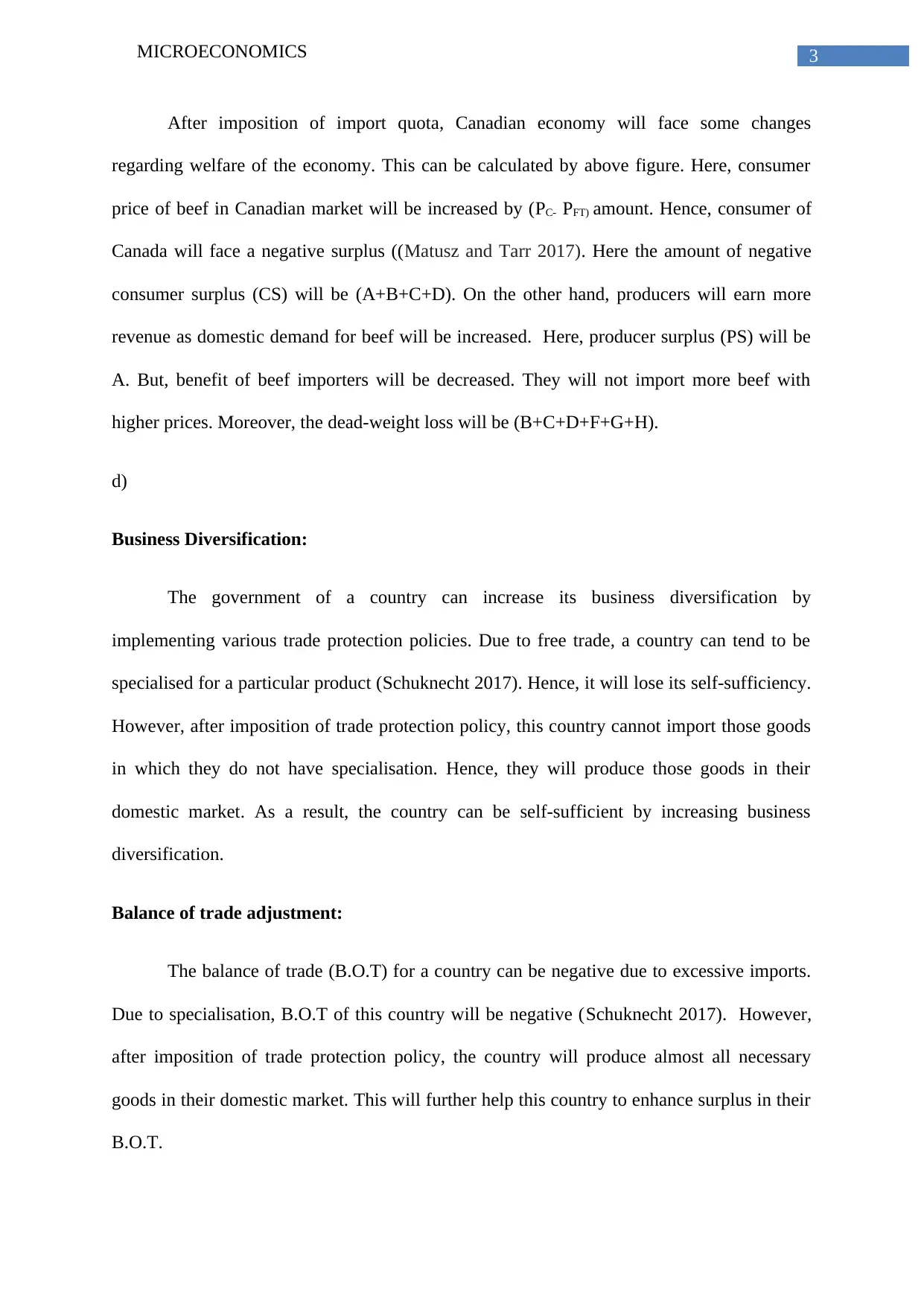
3MICROECONOMICS
After imposition of import quota, Canadian economy will face some changes
regarding welfare of the economy. This can be calculated by above figure. Here, consumer
price of beef in Canadian market will be increased by (PC- PFT) amount. Hence, consumer of
Canada will face a negative surplus ((Matusz and Tarr 2017). Here the amount of negative
consumer surplus (CS) will be (A+B+C+D). On the other hand, producers will earn more
revenue as domestic demand for beef will be increased. Here, producer surplus (PS) will be
A. But, benefit of beef importers will be decreased. They will not import more beef with
higher prices. Moreover, the dead-weight loss will be (B+C+D+F+G+H).
d)
Business Diversification:
The government of a country can increase its business diversification by
implementing various trade protection policies. Due to free trade, a country can tend to be
specialised for a particular product (Schuknecht 2017). Hence, it will lose its self-sufficiency.
However, after imposition of trade protection policy, this country cannot import those goods
in which they do not have specialisation. Hence, they will produce those goods in their
domestic market. As a result, the country can be self-sufficient by increasing business
diversification.
Balance of trade adjustment:
The balance of trade (B.O.T) for a country can be negative due to excessive imports.
Due to specialisation, B.O.T of this country will be negative (Schuknecht 2017). However,
after imposition of trade protection policy, the country will produce almost all necessary
goods in their domestic market. This will further help this country to enhance surplus in their
B.O.T.
After imposition of import quota, Canadian economy will face some changes
regarding welfare of the economy. This can be calculated by above figure. Here, consumer
price of beef in Canadian market will be increased by (PC- PFT) amount. Hence, consumer of
Canada will face a negative surplus ((Matusz and Tarr 2017). Here the amount of negative
consumer surplus (CS) will be (A+B+C+D). On the other hand, producers will earn more
revenue as domestic demand for beef will be increased. Here, producer surplus (PS) will be
A. But, benefit of beef importers will be decreased. They will not import more beef with
higher prices. Moreover, the dead-weight loss will be (B+C+D+F+G+H).
d)
Business Diversification:
The government of a country can increase its business diversification by
implementing various trade protection policies. Due to free trade, a country can tend to be
specialised for a particular product (Schuknecht 2017). Hence, it will lose its self-sufficiency.
However, after imposition of trade protection policy, this country cannot import those goods
in which they do not have specialisation. Hence, they will produce those goods in their
domestic market. As a result, the country can be self-sufficient by increasing business
diversification.
Balance of trade adjustment:
The balance of trade (B.O.T) for a country can be negative due to excessive imports.
Due to specialisation, B.O.T of this country will be negative (Schuknecht 2017). However,
after imposition of trade protection policy, the country will produce almost all necessary
goods in their domestic market. This will further help this country to enhance surplus in their
B.O.T.
Secure Best Marks with AI Grader
Need help grading? Try our AI Grader for instant feedback on your assignments.
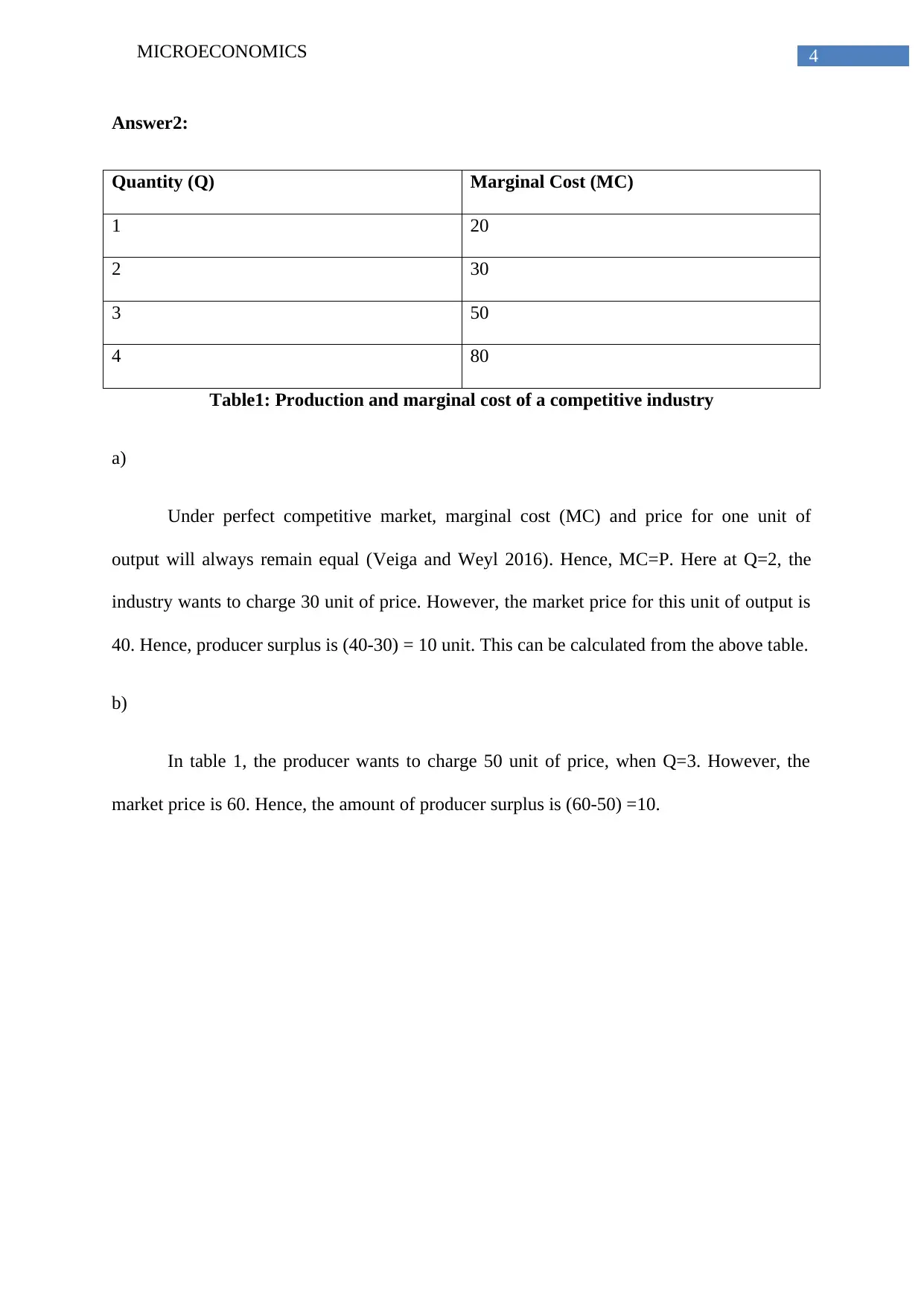
4MICROECONOMICS
Answer2:
Quantity (Q) Marginal Cost (MC)
1 20
2 30
3 50
4 80
Table1: Production and marginal cost of a competitive industry
a)
Under perfect competitive market, marginal cost (MC) and price for one unit of
output will always remain equal (Veiga and Weyl 2016). Hence, MC=P. Here at Q=2, the
industry wants to charge 30 unit of price. However, the market price for this unit of output is
40. Hence, producer surplus is (40-30) = 10 unit. This can be calculated from the above table.
b)
In table 1, the producer wants to charge 50 unit of price, when Q=3. However, the
market price is 60. Hence, the amount of producer surplus is (60-50) =10.
Answer2:
Quantity (Q) Marginal Cost (MC)
1 20
2 30
3 50
4 80
Table1: Production and marginal cost of a competitive industry
a)
Under perfect competitive market, marginal cost (MC) and price for one unit of
output will always remain equal (Veiga and Weyl 2016). Hence, MC=P. Here at Q=2, the
industry wants to charge 30 unit of price. However, the market price for this unit of output is
40. Hence, producer surplus is (40-30) = 10 unit. This can be calculated from the above table.
b)
In table 1, the producer wants to charge 50 unit of price, when Q=3. However, the
market price is 60. Hence, the amount of producer surplus is (60-50) =10.
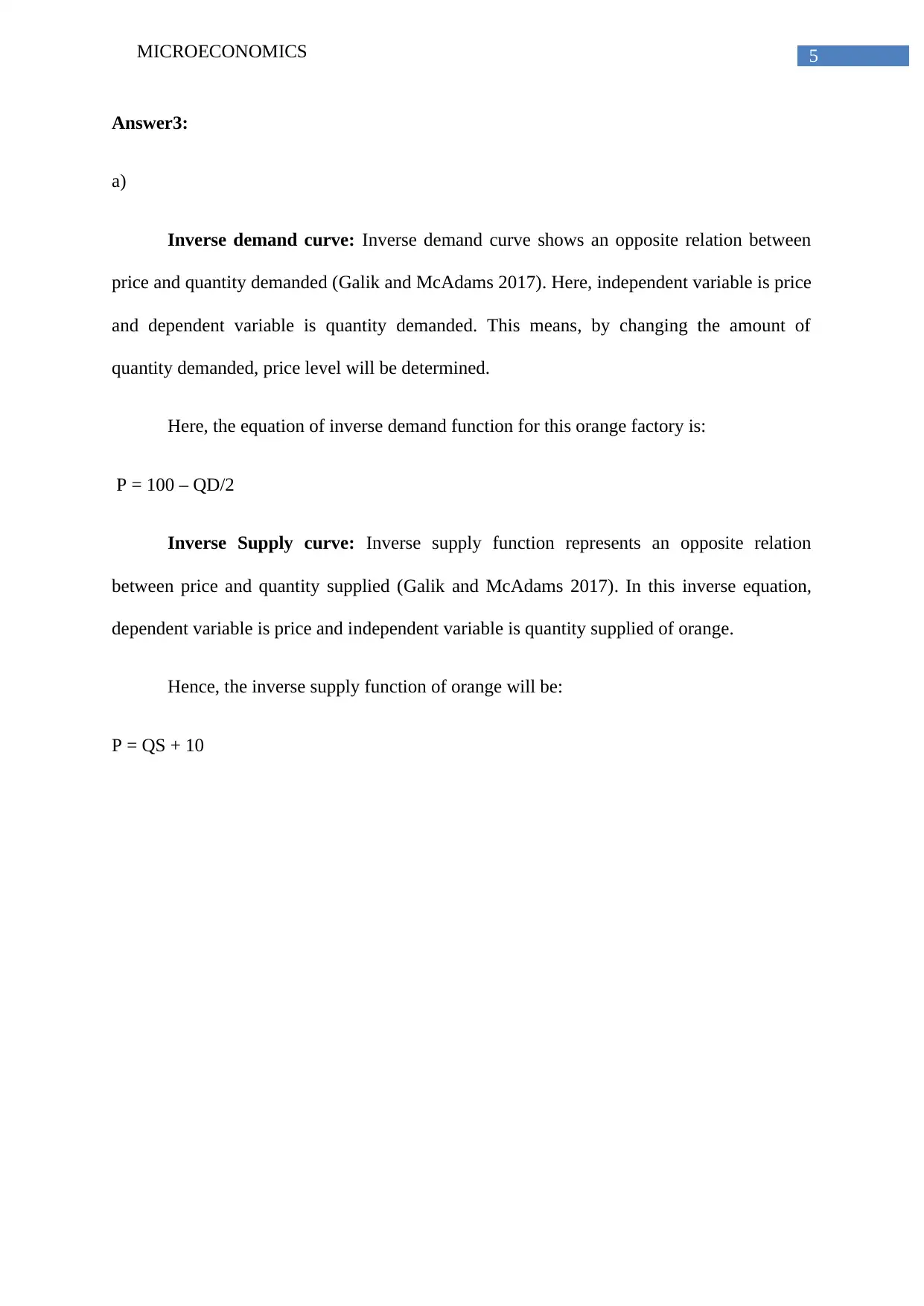
5MICROECONOMICS
Answer3:
a)
Inverse demand curve: Inverse demand curve shows an opposite relation between
price and quantity demanded (Galik and McAdams 2017). Here, independent variable is price
and dependent variable is quantity demanded. This means, by changing the amount of
quantity demanded, price level will be determined.
Here, the equation of inverse demand function for this orange factory is:
P = 100 – QD/2
Inverse Supply curve: Inverse supply function represents an opposite relation
between price and quantity supplied (Galik and McAdams 2017). In this inverse equation,
dependent variable is price and independent variable is quantity supplied of orange.
Hence, the inverse supply function of orange will be:
P = QS + 10
Answer3:
a)
Inverse demand curve: Inverse demand curve shows an opposite relation between
price and quantity demanded (Galik and McAdams 2017). Here, independent variable is price
and dependent variable is quantity demanded. This means, by changing the amount of
quantity demanded, price level will be determined.
Here, the equation of inverse demand function for this orange factory is:
P = 100 – QD/2
Inverse Supply curve: Inverse supply function represents an opposite relation
between price and quantity supplied (Galik and McAdams 2017). In this inverse equation,
dependent variable is price and independent variable is quantity supplied of orange.
Hence, the inverse supply function of orange will be:
P = QS + 10
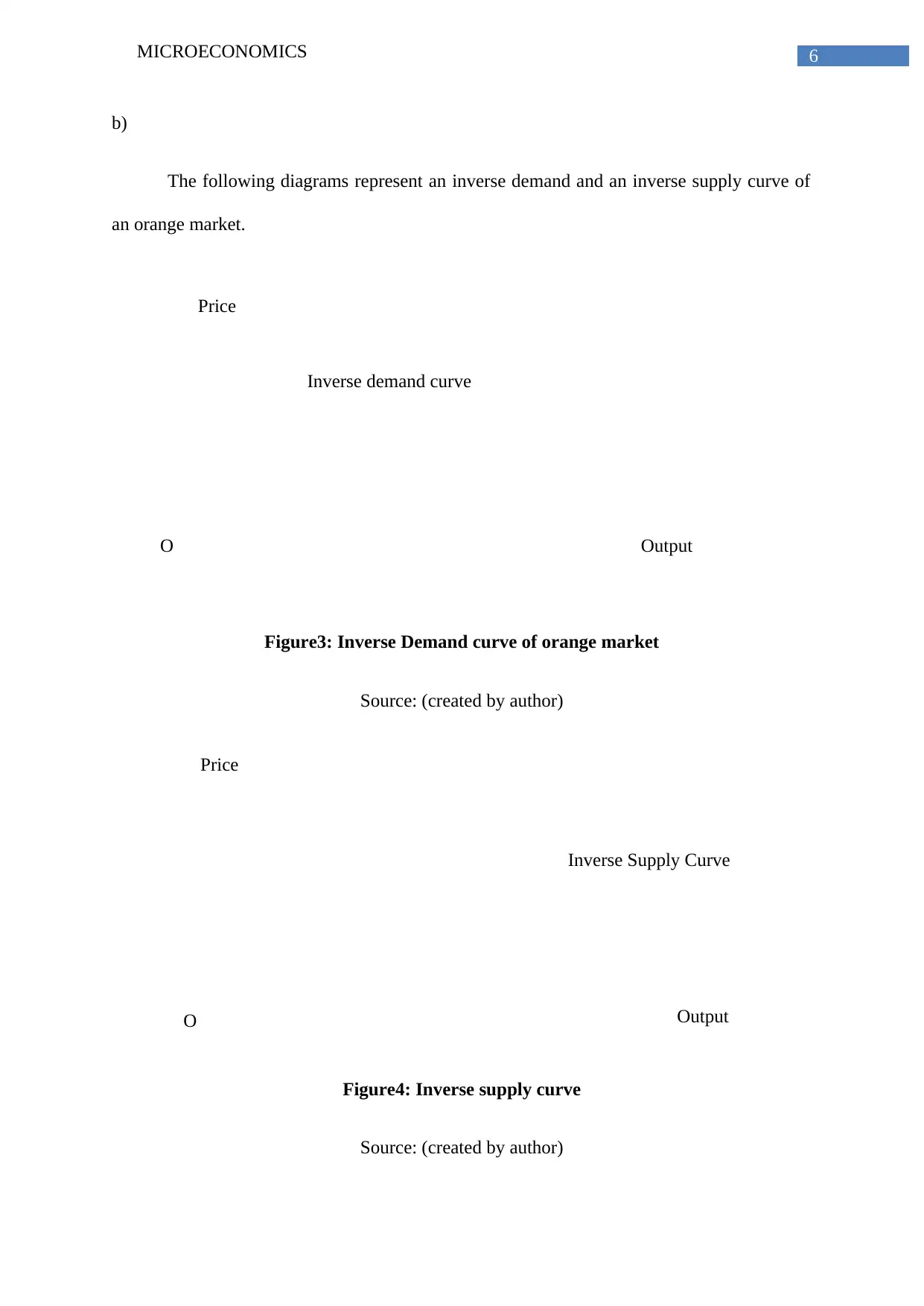
6MICROECONOMICS
Output
Price
O
Inverse demand curve
Output
Price
Inverse Supply Curve
O
b)
The following diagrams represent an inverse demand and an inverse supply curve of
an orange market.
Figure3: Inverse Demand curve of orange market
Source: (created by author)
Figure4: Inverse supply curve
Source: (created by author)
Output
Price
O
Inverse demand curve
Output
Price
Inverse Supply Curve
O
b)
The following diagrams represent an inverse demand and an inverse supply curve of
an orange market.
Figure3: Inverse Demand curve of orange market
Source: (created by author)
Figure4: Inverse supply curve
Source: (created by author)
Paraphrase This Document
Need a fresh take? Get an instant paraphrase of this document with our AI Paraphraser
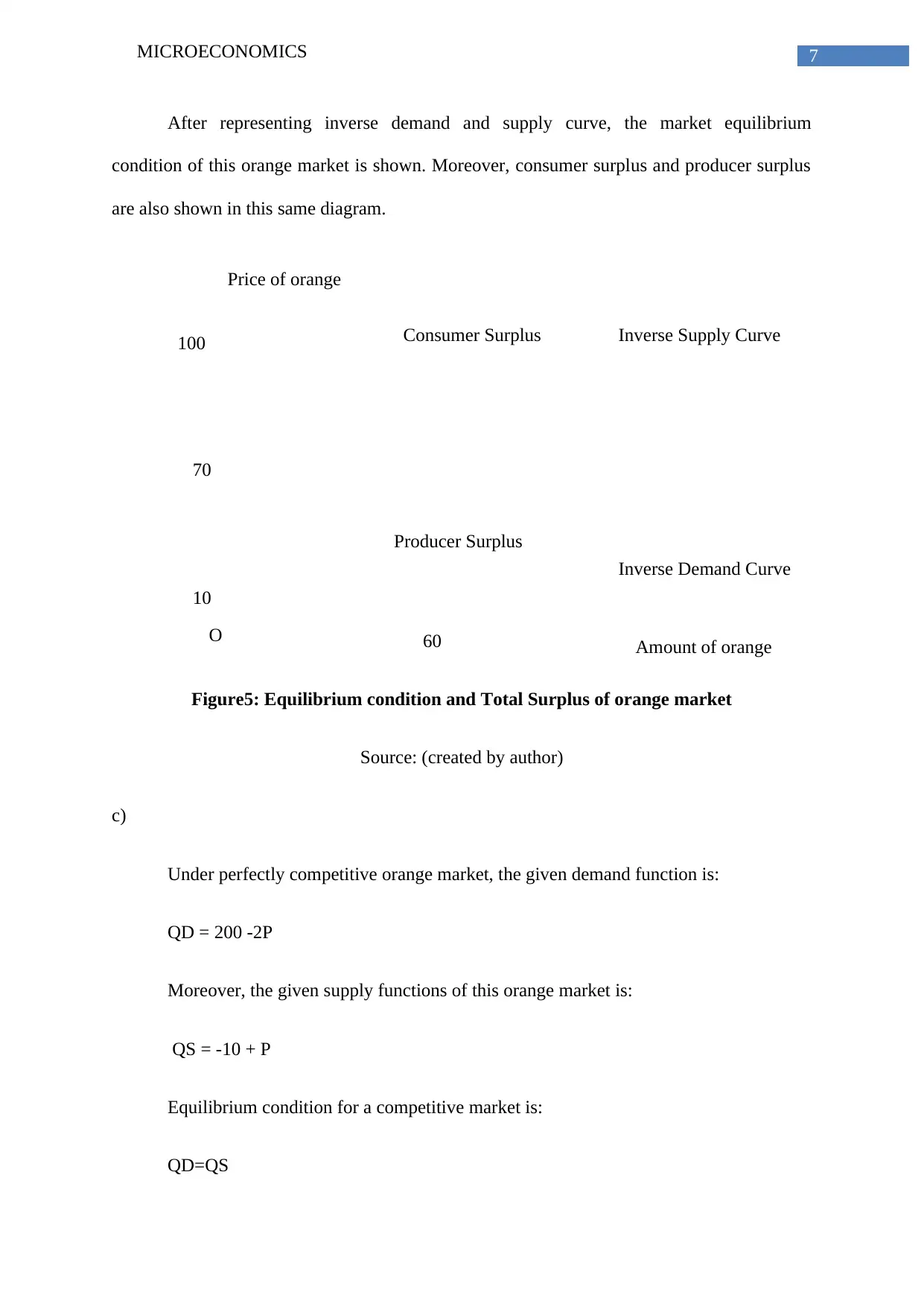
7MICROECONOMICS
60
70
Inverse Supply Curve
Inverse Demand Curve
Amount of orange
Price of orange
Consumer Surplus
Producer Surplus
100
10
O
After representing inverse demand and supply curve, the market equilibrium
condition of this orange market is shown. Moreover, consumer surplus and producer surplus
are also shown in this same diagram.
Figure5: Equilibrium condition and Total Surplus of orange market
Source: (created by author)
c)
Under perfectly competitive orange market, the given demand function is:
QD = 200 -2P
Moreover, the given supply functions of this orange market is:
QS = -10 + P
Equilibrium condition for a competitive market is:
QD=QS
60
70
Inverse Supply Curve
Inverse Demand Curve
Amount of orange
Price of orange
Consumer Surplus
Producer Surplus
100
10
O
After representing inverse demand and supply curve, the market equilibrium
condition of this orange market is shown. Moreover, consumer surplus and producer surplus
are also shown in this same diagram.
Figure5: Equilibrium condition and Total Surplus of orange market
Source: (created by author)
c)
Under perfectly competitive orange market, the given demand function is:
QD = 200 -2P
Moreover, the given supply functions of this orange market is:
QS = -10 + P
Equilibrium condition for a competitive market is:
QD=QS
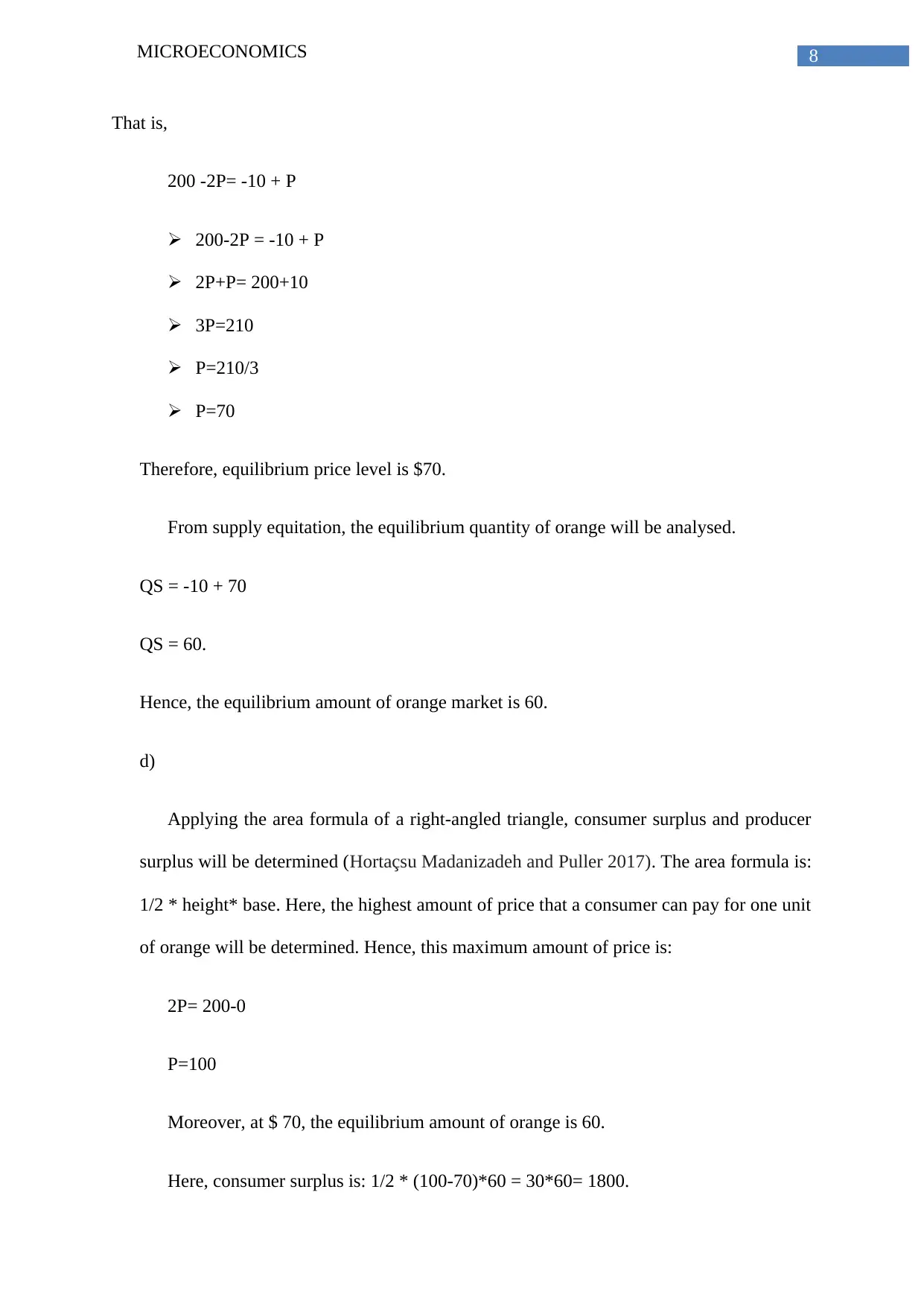
8MICROECONOMICS
That is,
200 -2P= -10 + P
200-2P = -10 + P
2P+P= 200+10
3P=210
P=210/3
P=70
Therefore, equilibrium price level is $70.
From supply equitation, the equilibrium quantity of orange will be analysed.
QS = -10 + 70
QS = 60.
Hence, the equilibrium amount of orange market is 60.
d)
Applying the area formula of a right-angled triangle, consumer surplus and producer
surplus will be determined (Hortaçsu Madanizadeh and Puller 2017). The area formula is:
1/2 * height* base. Here, the highest amount of price that a consumer can pay for one unit
of orange will be determined. Hence, this maximum amount of price is:
2P= 200-0
P=100
Moreover, at $ 70, the equilibrium amount of orange is 60.
Here, consumer surplus is: 1/2 * (100-70)*60 = 30*60= 1800.
That is,
200 -2P= -10 + P
200-2P = -10 + P
2P+P= 200+10
3P=210
P=210/3
P=70
Therefore, equilibrium price level is $70.
From supply equitation, the equilibrium quantity of orange will be analysed.
QS = -10 + 70
QS = 60.
Hence, the equilibrium amount of orange market is 60.
d)
Applying the area formula of a right-angled triangle, consumer surplus and producer
surplus will be determined (Hortaçsu Madanizadeh and Puller 2017). The area formula is:
1/2 * height* base. Here, the highest amount of price that a consumer can pay for one unit
of orange will be determined. Hence, this maximum amount of price is:
2P= 200-0
P=100
Moreover, at $ 70, the equilibrium amount of orange is 60.
Here, consumer surplus is: 1/2 * (100-70)*60 = 30*60= 1800.
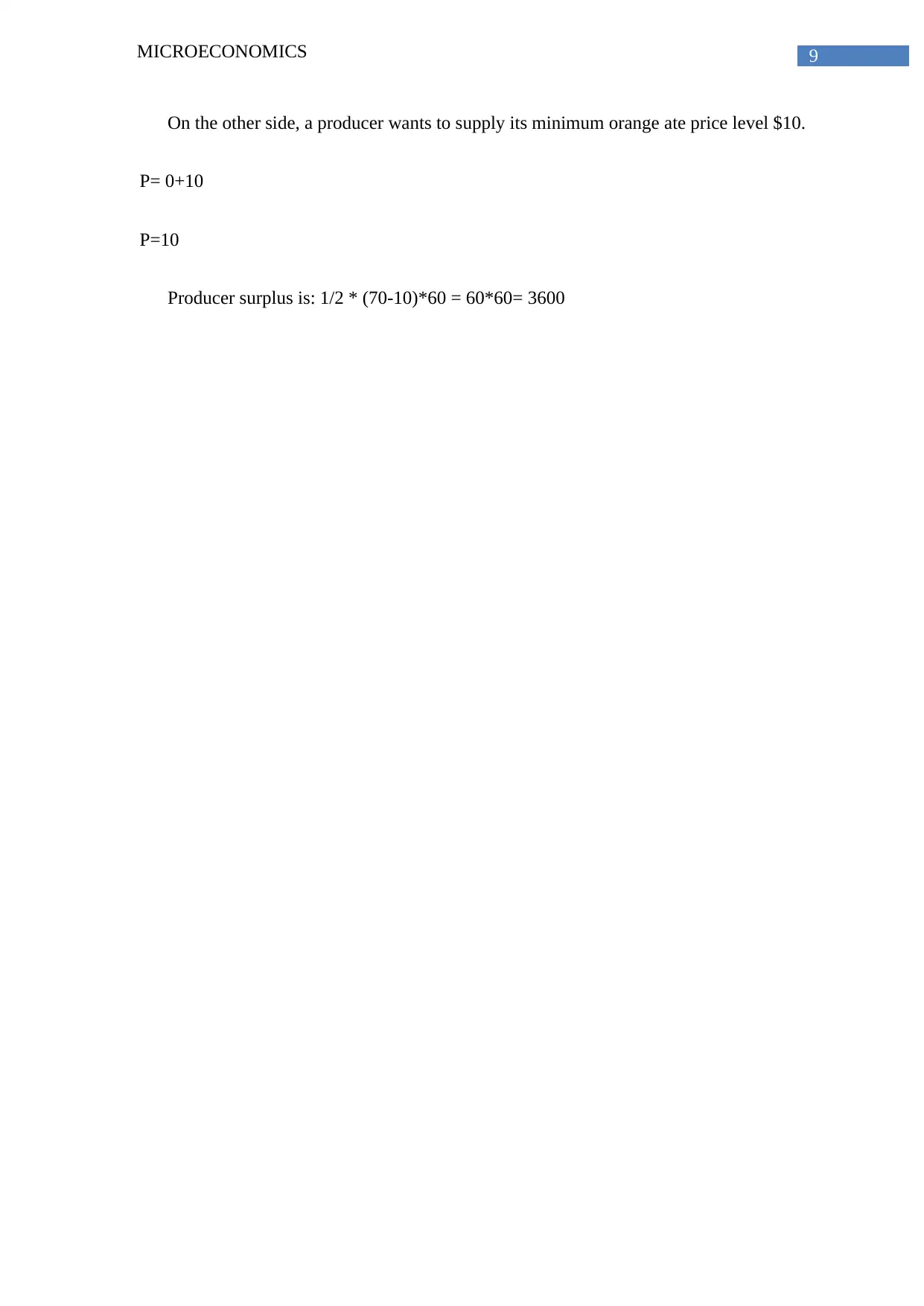
9MICROECONOMICS
On the other side, a producer wants to supply its minimum orange ate price level $10.
P= 0+10
P=10
Producer surplus is: 1/2 * (70-10)*60 = 60*60= 3600
On the other side, a producer wants to supply its minimum orange ate price level $10.
P= 0+10
P=10
Producer surplus is: 1/2 * (70-10)*60 = 60*60= 3600
Secure Best Marks with AI Grader
Need help grading? Try our AI Grader for instant feedback on your assignments.
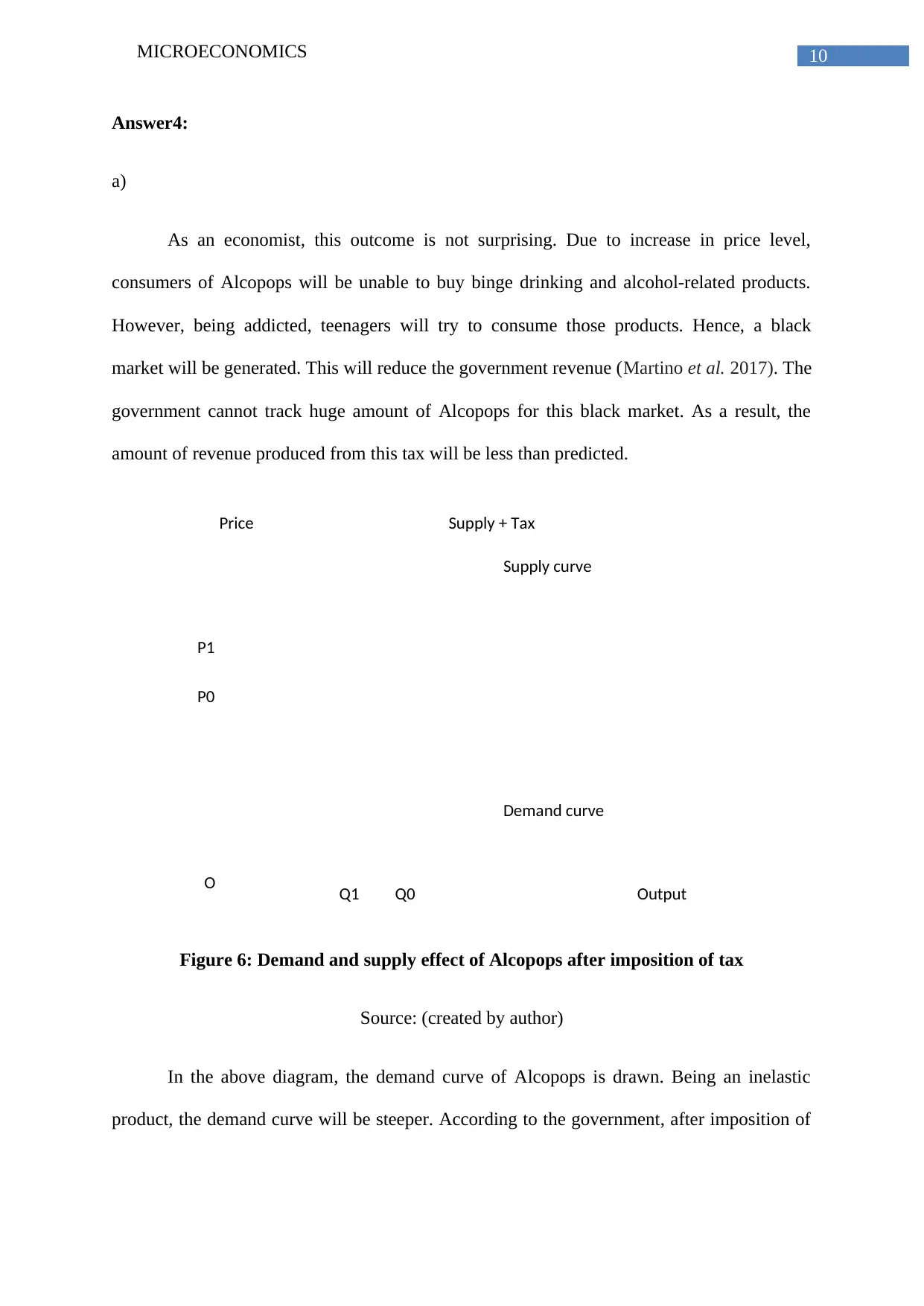
10MICROECONOMICS
Price
O Output
Demand curve
Supply curve
Supply + Tax
Q1 Q0
P1
P0
Answer4:
a)
As an economist, this outcome is not surprising. Due to increase in price level,
consumers of Alcopops will be unable to buy binge drinking and alcohol-related products.
However, being addicted, teenagers will try to consume those products. Hence, a black
market will be generated. This will reduce the government revenue (Martino et al. 2017). The
government cannot track huge amount of Alcopops for this black market. As a result, the
amount of revenue produced from this tax will be less than predicted.
Figure 6: Demand and supply effect of Alcopops after imposition of tax
Source: (created by author)
In the above diagram, the demand curve of Alcopops is drawn. Being an inelastic
product, the demand curve will be steeper. According to the government, after imposition of
Price
O Output
Demand curve
Supply curve
Supply + Tax
Q1 Q0
P1
P0
Answer4:
a)
As an economist, this outcome is not surprising. Due to increase in price level,
consumers of Alcopops will be unable to buy binge drinking and alcohol-related products.
However, being addicted, teenagers will try to consume those products. Hence, a black
market will be generated. This will reduce the government revenue (Martino et al. 2017). The
government cannot track huge amount of Alcopops for this black market. As a result, the
amount of revenue produced from this tax will be less than predicted.
Figure 6: Demand and supply effect of Alcopops after imposition of tax
Source: (created by author)
In the above diagram, the demand curve of Alcopops is drawn. Being an inelastic
product, the demand curve will be steeper. According to the government, after imposition of
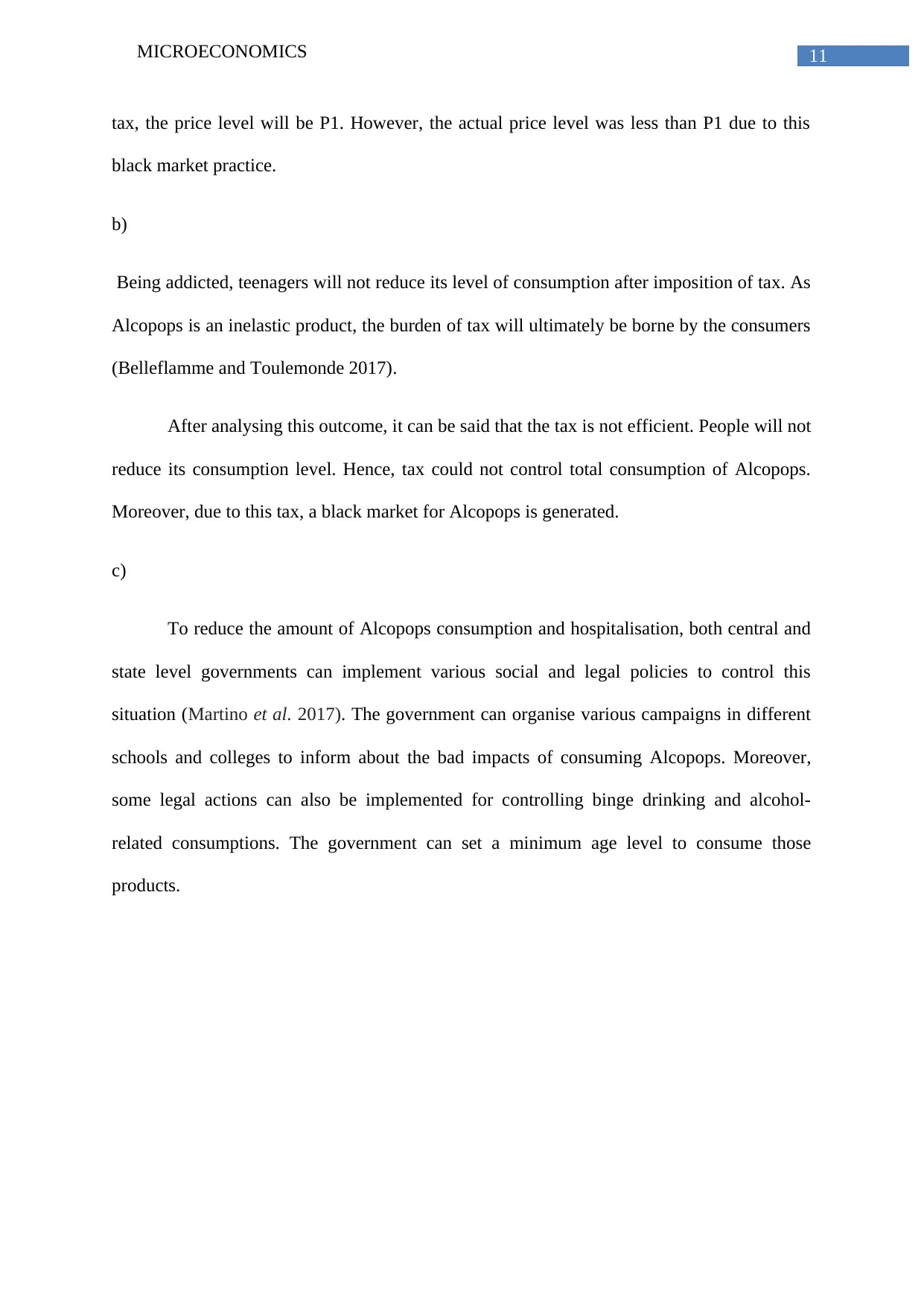
11MICROECONOMICS
tax, the price level will be P1. However, the actual price level was less than P1 due to this
black market practice.
b)
Being addicted, teenagers will not reduce its level of consumption after imposition of tax. As
Alcopops is an inelastic product, the burden of tax will ultimately be borne by the consumers
(Belleflamme and Toulemonde 2017).
After analysing this outcome, it can be said that the tax is not efficient. People will not
reduce its consumption level. Hence, tax could not control total consumption of Alcopops.
Moreover, due to this tax, a black market for Alcopops is generated.
c)
To reduce the amount of Alcopops consumption and hospitalisation, both central and
state level governments can implement various social and legal policies to control this
situation (Martino et al. 2017). The government can organise various campaigns in different
schools and colleges to inform about the bad impacts of consuming Alcopops. Moreover,
some legal actions can also be implemented for controlling binge drinking and alcohol-
related consumptions. The government can set a minimum age level to consume those
products.
tax, the price level will be P1. However, the actual price level was less than P1 due to this
black market practice.
b)
Being addicted, teenagers will not reduce its level of consumption after imposition of tax. As
Alcopops is an inelastic product, the burden of tax will ultimately be borne by the consumers
(Belleflamme and Toulemonde 2017).
After analysing this outcome, it can be said that the tax is not efficient. People will not
reduce its consumption level. Hence, tax could not control total consumption of Alcopops.
Moreover, due to this tax, a black market for Alcopops is generated.
c)
To reduce the amount of Alcopops consumption and hospitalisation, both central and
state level governments can implement various social and legal policies to control this
situation (Martino et al. 2017). The government can organise various campaigns in different
schools and colleges to inform about the bad impacts of consuming Alcopops. Moreover,
some legal actions can also be implemented for controlling binge drinking and alcohol-
related consumptions. The government can set a minimum age level to consume those
products.
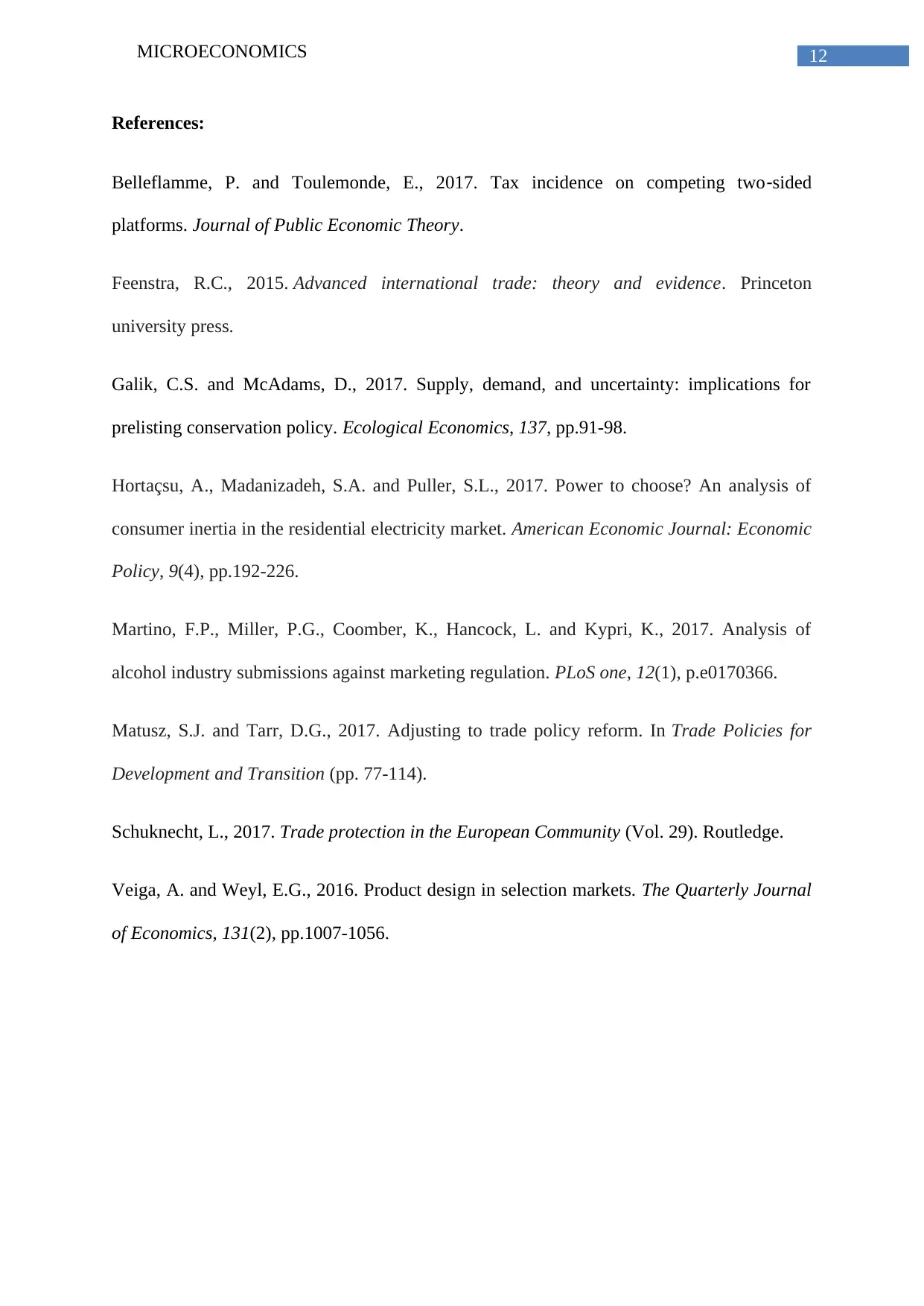
12MICROECONOMICS
References:
Belleflamme, P. and Toulemonde, E., 2017. Tax incidence on competing two‐sided
platforms. Journal of Public Economic Theory.
Feenstra, R.C., 2015. Advanced international trade: theory and evidence. Princeton
university press.
Galik, C.S. and McAdams, D., 2017. Supply, demand, and uncertainty: implications for
prelisting conservation policy. Ecological Economics, 137, pp.91-98.
Hortaçsu, A., Madanizadeh, S.A. and Puller, S.L., 2017. Power to choose? An analysis of
consumer inertia in the residential electricity market. American Economic Journal: Economic
Policy, 9(4), pp.192-226.
Martino, F.P., Miller, P.G., Coomber, K., Hancock, L. and Kypri, K., 2017. Analysis of
alcohol industry submissions against marketing regulation. PLoS one, 12(1), p.e0170366.
Matusz, S.J. and Tarr, D.G., 2017. Adjusting to trade policy reform. In Trade Policies for
Development and Transition (pp. 77-114).
Schuknecht, L., 2017. Trade protection in the European Community (Vol. 29). Routledge.
Veiga, A. and Weyl, E.G., 2016. Product design in selection markets. The Quarterly Journal
of Economics, 131(2), pp.1007-1056.
References:
Belleflamme, P. and Toulemonde, E., 2017. Tax incidence on competing two‐sided
platforms. Journal of Public Economic Theory.
Feenstra, R.C., 2015. Advanced international trade: theory and evidence. Princeton
university press.
Galik, C.S. and McAdams, D., 2017. Supply, demand, and uncertainty: implications for
prelisting conservation policy. Ecological Economics, 137, pp.91-98.
Hortaçsu, A., Madanizadeh, S.A. and Puller, S.L., 2017. Power to choose? An analysis of
consumer inertia in the residential electricity market. American Economic Journal: Economic
Policy, 9(4), pp.192-226.
Martino, F.P., Miller, P.G., Coomber, K., Hancock, L. and Kypri, K., 2017. Analysis of
alcohol industry submissions against marketing regulation. PLoS one, 12(1), p.e0170366.
Matusz, S.J. and Tarr, D.G., 2017. Adjusting to trade policy reform. In Trade Policies for
Development and Transition (pp. 77-114).
Schuknecht, L., 2017. Trade protection in the European Community (Vol. 29). Routledge.
Veiga, A. and Weyl, E.G., 2016. Product design in selection markets. The Quarterly Journal
of Economics, 131(2), pp.1007-1056.
1 out of 13
Related Documents
Your All-in-One AI-Powered Toolkit for Academic Success.
+13062052269
info@desklib.com
Available 24*7 on WhatsApp / Email
![[object Object]](/_next/static/media/star-bottom.7253800d.svg)
Unlock your academic potential
© 2024 | Zucol Services PVT LTD | All rights reserved.





